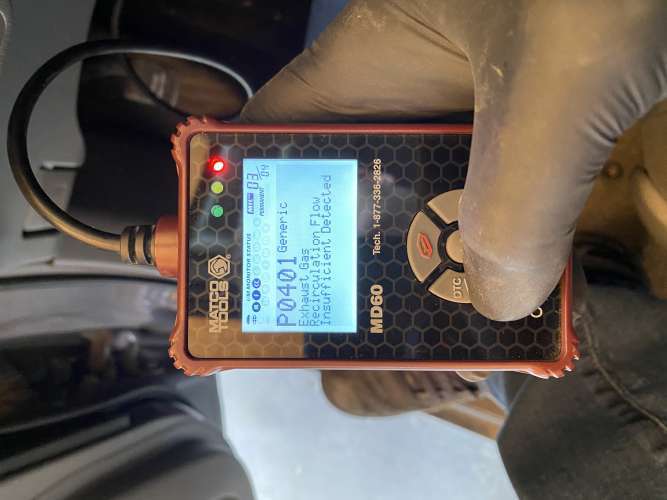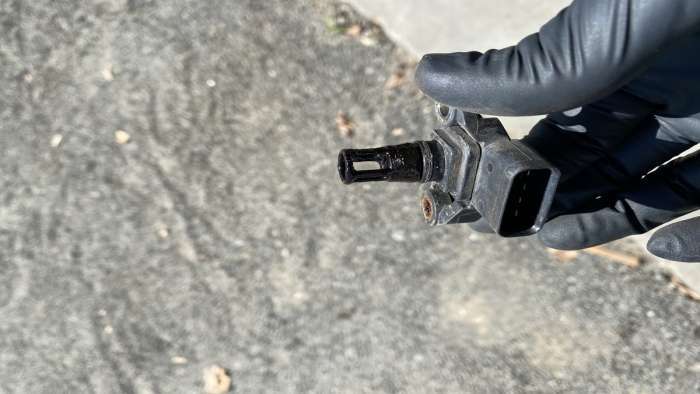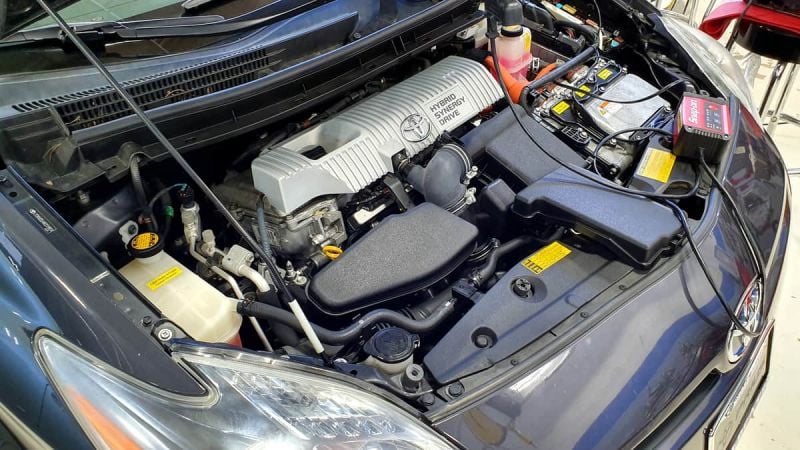Hey everyone! Pete, The Hybrid Guy here, and I am pumped to tell you about how I solved the pesky P0401 EGR insufficient flow on my 2010 Toyota Prius. If you remember, this is the car that I was wondering if it was a mistake buying it. So far, it has been a great car, until this code, the P0401.
To help everyone who encounters this issue, I need first to explain a few things. Once you have an understanding of what the system is doing, I can then better assist you in knowing how to fix it.
Understanding The Toyota Prius P0401 Trouble Code
To know how to solve your EGR insufficient flow problem, you must first understand what the system does. The Exhaust Gas Recirculation is designed to help lower combustion temps inside the engine and ultimately help reduce tailpipe emissions. That is pretty basic. Know that it is there to help keep emissions down.
Most systems have several components that make up the entire EGR assembly. In our case, for Gen 3 Toyota Prius, we have an EGR cooler, an EGR valve, piping, gaskets, sensors, and even a neat stepper motor. All of these components must work together for the computer to keep that pesky check engine light off.

The way that a P0401 is triggered on a 3rd Generation Toyota Prius is when one or more of the following happens. The EGR valve quits working, that MAP (manifold absolute pressure) sensor malfunctions or the EGR system became clogged with carbon deposits. The carbon deposits are typically what causes an insufficient flow problem.
Carbon deposits are going to happen whether we like it or not. There are ways to minimize carbon build-up in your EGR system, but that is for another article. Due to how the EGR system is built on Gen 3 Prius, we have many places where these deposits can land and build up.
Once there are enough deposits in the system, the pressure difference in the intake manifold is recognized by the MAP sensor, which monitors pressure changes, and the trouble code can set. This carbon deposits problem is usually what happens to our EGR systems, and can be fixed for a few hours of your time. I will also cover this in another article about the cleaning process.
A P0401 is almost always caused by carbon build-up. In my case, when I repaired the head gasket on the Prius, I cleaned everything on that system to ensure it was perfect. However, it was not. The trouble code came on and stayed regardless of how clean it was. It was then I needed more information on how to fix the root issue of the problem.
Finding The Root Cause Of The P0401
As any good technician would do, I turned to troubleshoot and component testing. I found out that five main areas can be at fault to set this code. The fields are the EGR valve, MAP sensor, EGR pipe, EGR cooler, or the ECM.
Logic would tell me to take a hard look at this list and determine what the simplest tests that can be performed without spending money and do those first are.
First, I reconfirmed that my EGR passages were clean. This confirmation process took me about an hour, but I was 100% sure that I had plenty of flow from the cooler up to the manifold and into the intake ports.
Second, I started component testing, beginning with the MAP sensor. I then did what Toyota calls for and back probed into the MAP sensor while in the circuit. I was able to determine that it was operating within specifications. I did this using a multimeter and my back probe wires.
Third, I resistance tested the EGR valve on the motor coils and used a scan tool to command the valve open. Everything seemed fine. I had gone entirely through my list, and the last thing was the ECM. I was mortified that Toyota would have a faulty computer, so I decided to take one more leap of faith and try something I had done before. A known-good car with known-good components.
Luckily for me, I knew a few people with a Prius and was able to pick up another 3rd Gen pretty easy. The idea here was going through components one by one until I found the culprit. My first stop. The MAP sensor.

The MAP was covered in oil when I pulled it out. The measurement I was able to obtain from it was also not exactly what I thought either even though it was within specification I was skeptical. I swapped the sensor, cleared the code, and went for a drive. No luck, the system tripped P0401, but I knew my MAP original sensor was suitable.
Test two, because test one had thrown me for a loop, I decided to swap the VVTI sensor, there was absolutely no reason other than was curious. Sure enough, not the issue.
The third component test is what threw me for a loop. I had tested the EGR valve motor, which tested fine, and the scan tool also commanded it on and off accordingly. I was sure it was not it, but I was determined to try. Rather than swap the whole unit, I decided to take the easy road on this one and swap the motor only as I knew that the mechanical part of the valve was 100% fine.
I swapped the motor, magnet and spring connected it, cleared the code then went for a drive. At this point, I had a sure path to follow that would always trip the system. This time was different; the code did not set even after I tried again and again. No code.
I went as far as to do the Toyota recommended confirmation clear drive pattern, and sure enough, the code cleared. No more trouble. I needed an EGR motor, magnet, and spring.
Key Take-Away
The testing methods that I have described here are a combination of years of experience with a dash of wild intuition. Toyota builds very high-quality vehicles, and while you can have a faulty ECU, the chances are very slim.
I will be doing a lab scope test to prove that my EGR valve motor is faulty. I only did not because I have to borrow one. I am sure that I will find an irregular pattern when the valve is commanded on by the computer under the criteria. I wholeheartedly believe that the actual electrical circuit is okay but that I may have a crack in the magnet or weak spring. Either way, I need to replace the valve motor.
I did these tests because a MAP sensor was $192 from the dealer and even more aftermarket. An EGR valve was dang near $300 from the dealer and about that same price aftermarket as well. I am not one to throw money at components without knowing for sure they are faulty.
Sure, I could have randomly replaced both of those two components but who wants to spend over $500 when you could know precisely what the issue is. I found a known suitable used valve on eBay for $90 shipped which I will pull the motor, spring and magnet should take about 5 minutes then I will be good to go.
I hope this helps some of you out there. Be aware that you need to ensure that the mechanical part of your EGR valve is moving freely. If the valve sticks at all, replace the whole unit. You can also replace the entire valve if you want a new component in your car.
Thank you for reading. I look forward to seeing you in the next article. Is The Paid Dr. Prius App Worth It?
Have questions on your P0401 on a Prius? Feel free to message me. I am more than willing to help. Be sure to check us out and join the movement on Facebook too at Green Car Movement for weekly giveaways and to help other people.
Watch this Toyota Prius truck with a nice little bed and click to subscribe to Torque News Youtube for daily automotive news analysis.
Peter Neilson is an automotive consultant specializing in electric cars and hybrid battery technologies. He holds a Bachelor of Science in Automotive Service Technology from Weber State University. Peter is also an Instructor of Automotive Technology at Columbia Basin College. Peter can be reached on Linkedin and you can tweet him at The_hybrid_guy on Twitter. Find his page on Facebook at Certified Auto Consulting. Read more of Peter's stories at Toyota news coverage on Torque News. Search Toyota Prius Torque News for more in depth Prius coverage from our reporters












Comments
Had the same issue with P0401
Permalink
Had the same issue with P0401, I cleaned everything, and I too took apart the stepper motor, I am wondering if you got a look of the magnet. My magnet looked like something broken off inside.
Someone also mentioned that the magnet need to be reinstall with the magnet fully screwed in.
What is the Mileage of your
Permalink
What is the Mileage of your used prius? it already had head gasket failure before, usually the cat also failed when head gasket fail. I am wondering if it is caused by the coolant being sucked back to the EGR valve and caused this problem. I do not understand how the motor failed if the valve is not clogged, probably just failed coils and you got lemon motors. What i understand, that one is brushless stepping motor, not like doors actuators that fail very often in many Toyota with automatic lock and unlock like in Sienna.
more testing of the p0401 and
Permalink
More testing of the p0401 and then we will have to get back on track with this one.
Hi has anyone figured out how
Permalink
Hi has anyone figured out how to repair the motor its self, or is the problem with the magnet? cheers :)
Thanks for the great info on
Permalink
Thanks for the great info on the P0401 code. I am getting code P0301 on my 2010 Prius with 213,000 miles. It knocks loudly when it starts. I pulled the egr valve and tube and cleaned it thoroughly but didn’t check the motor and spring. I think that could be my issue as well. I constantly get a misfire in cylinder one fault. Thanks again for the troubleshooting advice.
I am afraid your head gasket
Permalink
I am afraid your head gasket failed. Misfire in cyl. 1 or 2 is very common when head gasket leaks. Especially if you have 2010-2012. 2013 have revised head gasket that usually last much longer than 2010.
Hi Peter,
Permalink
Hi Peter,
How does the EGR motor work under different loads?
No error code after the
Permalink
No error code after the inverter failed but when turning of the car the engine diesel as if it will jump out of the car, so how can I test the removed EGR valve with a volt meter and a 12 volt power supply?
Hi there not sure you’ll get
Permalink
Hi there not sure you’ll get this but if so I’m wondering how I could test the egr magnet? Without replacing the unit itself with a good one?
A used prius I just bought, 2010 just popped the P0401 code.
Thanks!
I am becoming more aware of
Permalink
I am becoming more aware of the EGR valve and cooling unit becoming clogged as I read more articles from different places. We also have a hybrid Camry 2018 and hybrid Highlander 2021. What is the liklihood that these 2 vehicles will experience the same problem?
Early generation lll Priuses
Permalink
In reply to I am becoming more aware of by Steve (not verified)
Early generation lll Priuses had recalls covered for up to 150k miles. I had 2010 and did cleaned the lines and the intake passages and the motor and still was getting the code every now and then! On my second 2010 Prius, I only replaced the motor with a used from junkyard and it went away! I wouldn't worry about the other Toyota Hybrid models. I am not a big fan of the early lll Priuses because of head gasket issues too. I have had 2009 & 2013 Camry Hybrid with a lot less troubles. They are down on the price too because are not as popular as Priuses.
I How long would I expect it
Permalink
In reply to Early generation lll Priuses by Ron (not verified)
I How long would I expect it to take to thoroughly clean the EGR valve in a 2012 Prius. One of the hybrid techs at a local Toyota dealer has been letting his sit in a bucket of cleaner of some sort and says it take days for it to soak.
How long does it take to
Permalink
How long does it take to clean carbon from the EGR valve and cooler? What is the best method to do this.
I performed an egr cleaning…
Permalink
In reply to How long does it take to by STEVE (not verified)
I performed an egr cleaning on my toyota prius just this weekend, after I found an endless number of tutorials on the topic. Although the principals behind the procedure are simple and straight forward, I can tell you from personal experience that they are not easy. SIMPLE, but not EASY, if that makes sense. If it helps anyone, here are the best pointers I found in step-by-step form, the first one in particular is probably the best in terms of accurately illustrating all the difficulties and pitfalls.
youtube.com/watch?v=DTcBJm3N5nA
youtube.com/watch?v=2_Hr2tAK7-c
Also, the removal of the egr cooler seems to be a major source of discouragement as discussed in this forum: priuschat.com/threads/2015-prius-egr-headgasket-question.243125/#post-3394596